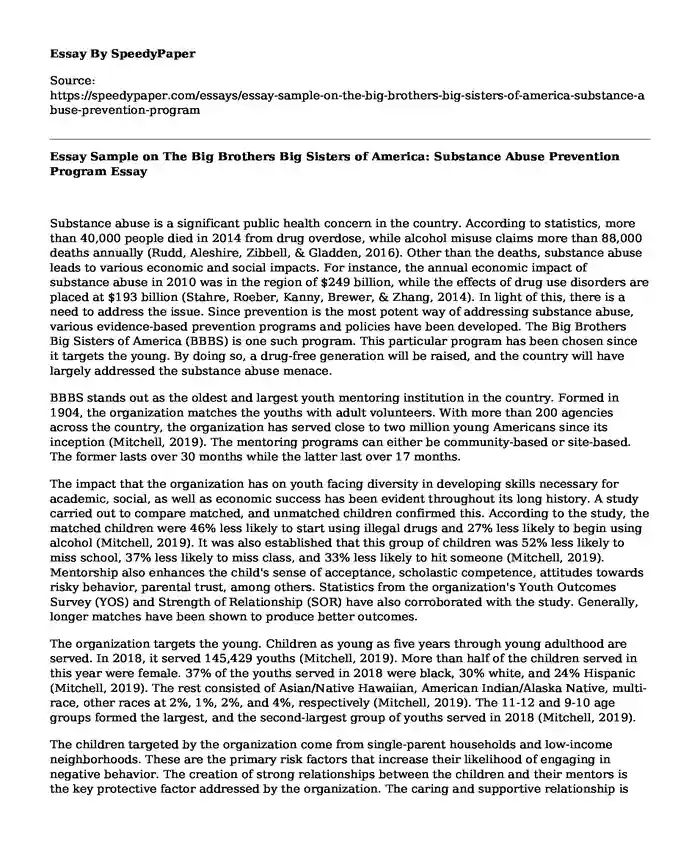
| Type of paper: | Research paper |
| Categories: | Substance abuse |
| Pages: | 3 |
| Wordcount: | 667 words |
Substance abuse is a significant public health concern in the country. According to statistics, more than 40,000 people died in 2014 from drug overdose, while alcohol misuse claims more than 88,000 deaths annually (Rudd, Aleshire, Zibbell, & Gladden, 2016). Other than the deaths, substance abuse leads to various economic and social impacts. For instance, the annual economic impact of substance abuse in 2010 was in the region of $249 billion, while the effects of drug use disorders are placed at $193 billion (Stahre, Roeber, Kanny, Brewer, & Zhang, 2014). In light of this, there is a need to address the issue. Since prevention is the most potent way of addressing substance abuse, various evidence-based prevention programs and policies have been developed. The Big Brothers Big Sisters of America (BBBS) is one such program. This particular program has been chosen since it targets the young. By doing so, a drug-free generation will be raised, and the country will have largely addressed the substance abuse menace.
BBBS stands out as the oldest and largest youth mentoring institution in the country. Formed in 1904, the organization matches the youths with adult volunteers. With more than 200 agencies across the country, the organization has served close to two million young Americans since its inception (Mitchell, 2019). The mentoring programs can either be community-based or site-based. The former lasts over 30 months while the latter last over 17 months.
The impact that the organization has on youth facing diversity in developing skills necessary for academic, social, as well as economic success has been evident throughout its long history. A study carried out to compare matched, and unmatched children confirmed this. According to the study, the matched children were 46% less likely to start using illegal drugs and 27% less likely to begin using alcohol (Mitchell, 2019). It was also established that this group of children was 52% less likely to miss school, 37% less likely to miss class, and 33% less likely to hit someone (Mitchell, 2019). Mentorship also enhances the child's sense of acceptance, scholastic competence, attitudes towards risky behavior, parental trust, among others. Statistics from the organization's Youth Outcomes Survey (YOS) and Strength of Relationship (SOR) have also corroborated with the study. Generally, longer matches have been shown to produce better outcomes.
The organization targets the young. Children as young as five years through young adulthood are served. In 2018, it served 145,429 youths (Mitchell, 2019). More than half of the children served in this year were female. 37% of the youths served in 2018 were black, 30% white, and 24% Hispanic (Mitchell, 2019). The rest consisted of Asian/Native Hawaiian, American Indian/Alaska Native, multi-race, other races at 2%, 1%, 2%, and 4%, respectively (Mitchell, 2019). The 11-12 and 9-10 age groups formed the largest, and the second-largest group of youths served in 2018 (Mitchell, 2019).
The children targeted by the organization come from single-parent households and low-income neighborhoods. These are the primary risk factors that increase their likelihood of engaging in negative behavior. The creation of strong relationships between the children and their mentors is the key protective factor addressed by the organization. The caring and supportive relationship is crucial for youths and helps keep them from beginning to misuse drugs.
Though the program has recorded high levels of success over the years, some measures can be taken to ensure maximum effectiveness. For instance, the YOS should be tailored to be more responsive to time. Both the community-based and site-based matches should also be lengthened since it has been proven that the longer the period, the higher the impact.
References
Mitchell, J. (2019). 2018 Big Brothers Big Sisters of America Annual Impact Report.
Rudd, R. A., Aleshire, N., Zibbell, J. E., & Gladden, R. M. (2016). Increases in drug and opioid overdose deaths-United States, 2000-2014. American Journal of Transplantation, 16(4), 1323-1327. Retrieved from https://www.cdc.gov/mmwr/volumes/65/wr/mm655051e1.htm?utm_campaign=colorado.ourcommunitynow.com%20website&utm_sourc
Stahre, M., Roeber, J., Kanny, D., Brewer, R. D., & Zhang, X. (2014). Peer reviewed: Contribution of excessive alcohol consumption to deaths and years of potential life lost in the United States. Preventing Chronic Disease, 11. Retrieved from https://www.ncbi.nlm.nih.gov/pmc/articles/PMC4075492/
Cite this page
Essay Sample on The Big Brothers Big Sisters of America: Substance Abuse Prevention Program. (2023, Mar 16). Retrieved from https://speedypaper.com/essays/essay-sample-on-the-big-brothers-big-sisters-of-america-substance-abuse-prevention-program
Request Removal
If you are the original author of this essay and no longer wish to have it published on the SpeedyPaper website, please click below to request its removal:
- Job Performance and Class Performance, Free Essay Sample
- Professional Development for Teachers, Free Essay Sample
- River Pollution - Free Essay on the Environmental Issue
- Free Paper Example on Managing Hospital Bed Capacity
- Behaviorism Approach to Education, Free Essay Sample
- Janie Crawford Character Analysis Essay, Free Example
- Free Paper on Understanding a Diagnostic Approach to Assessing and Teaching Reading
Popular categories




